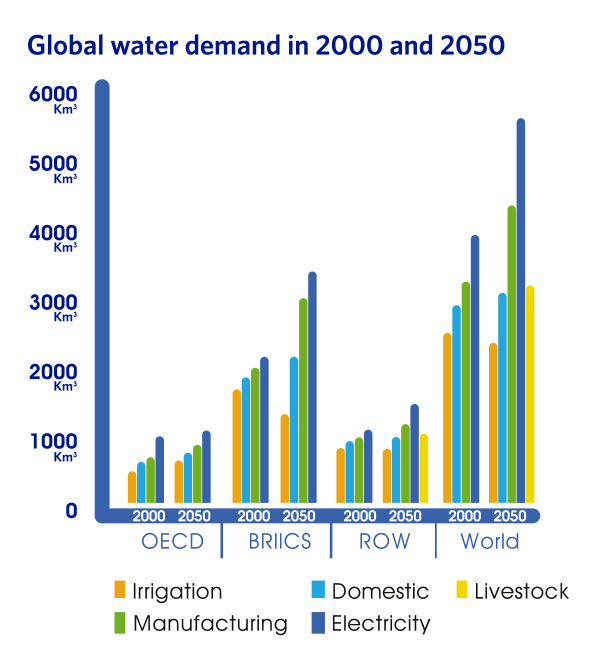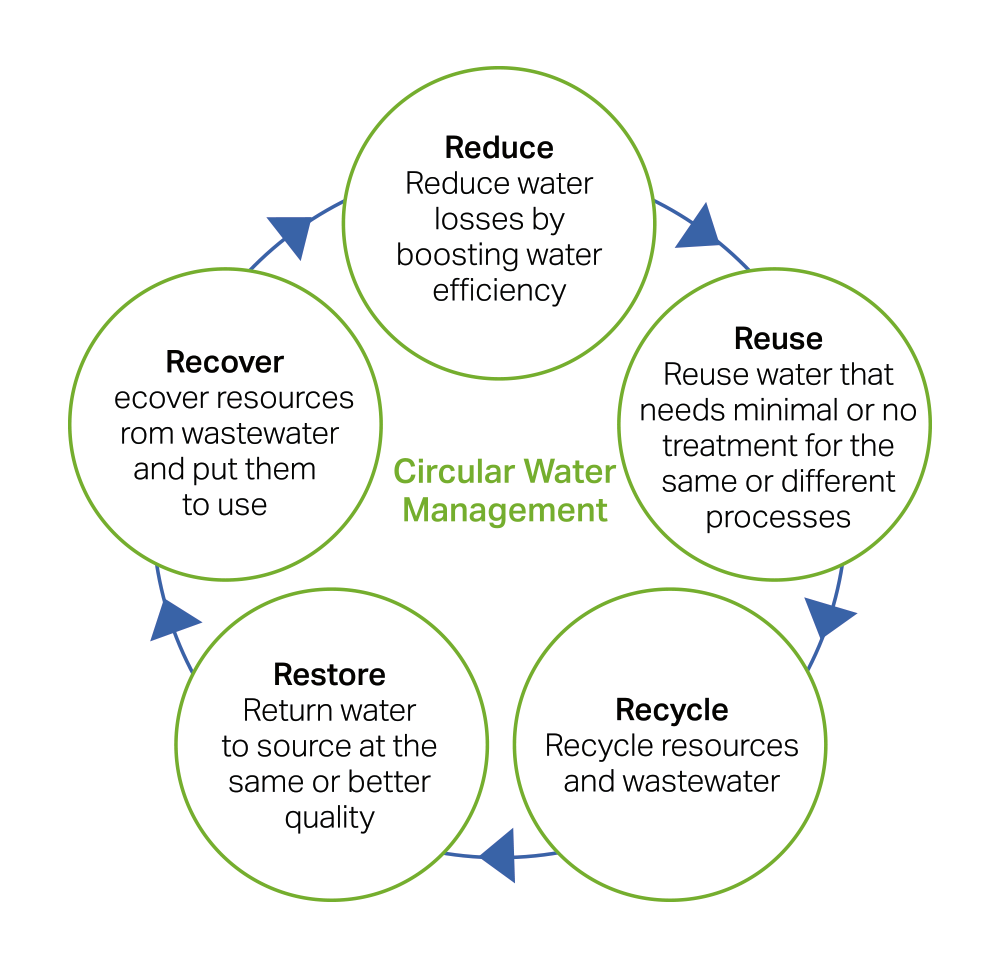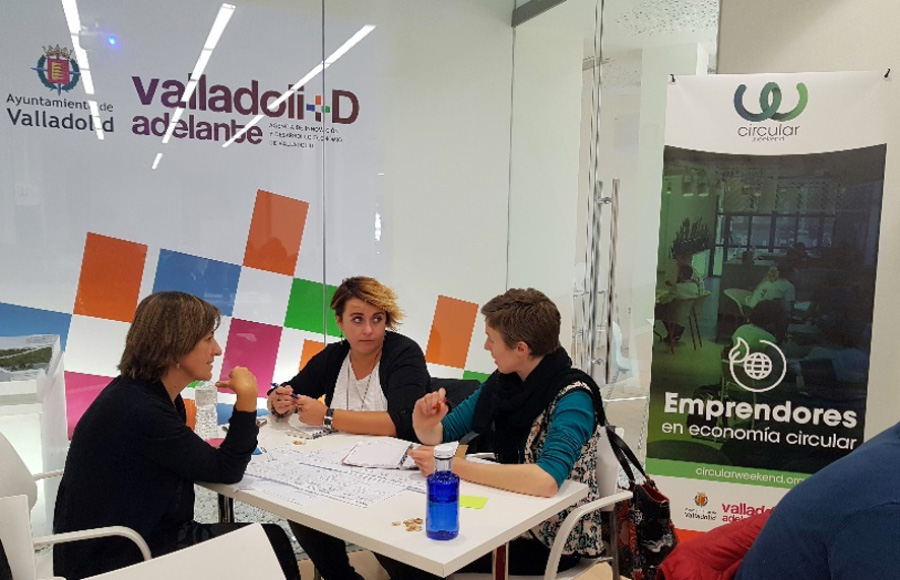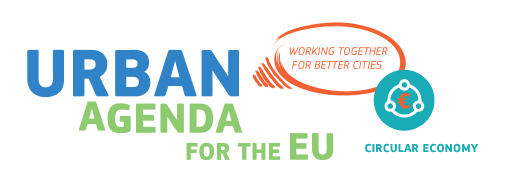Water and wastewater
What are the benefits of a circular water system?
Our lifestyles have become increasingly more water-intensive, putting a large strain on often scarce local water resources.1 The demand for water is expected to grow further due to climate change and growing urban populations2 (see figure 1)3. At the same time, current linear water systems use large quantities of clean water and energy, while wastewater treatment processes fail to recover valuable nutrients.4 A shift is required towards a more circular water system. This would entail closing loops to minimise the extraction and pollution of local waterways.1 In addition, reusing treated wastewater can be a new source of water supply, while alleviating pressure on local water resources and decreasing overall costs.5 Switching to a circular water system is especially relevant for cities, as circular water use is most beneficial when the point of reuse is close to the point of production.6

Figure 1: Global water demand in 2000 and 2050.
(Water Europe, 2017)
What will a circular water system look like?
According to the European Water Platform, a ‘water smart’ society requires the implementation of a water system that is in line with the following principles:3
- A reduced impact of society on water resources
- Delivering the true value of water for society, the economy, and the environment
- Securing society’s long-term resilience, stability, sustainability, and security regarding water
How can we transform our water system into a circular water system?
Different strategies can be used to incorporate circular economy principles into the water sector. Figure 22 shows that in every stage of water management, improvements can be made. Some examples:
- Circular design models: building green infrastructure like green roofs can reduce runoff of water into a city’s sewerage system, while also reducing the urban heat island effect.7 Creating local loops of water, for example at the level of apartment blocks or industrial sites, can ensure that water from these places is recycled and reused.3 When designing a wastewater treatment plant, it should – in the early phase – be ensured that it can recycle water, or at least is provided with connections for future advanced treatment modules. Ideally, the wastewater treatment plant should also be integrated into a nature-based ecosystem.2

Figure 2: The 5rs for circular water management.
(WBCSD, 2017)
- Use and life extension models: during the usage phase of water, reducing the consumption of drinking water through demand measures is important. Using a fit-for-purpose method, non-drinking water can be used for e.g. cleaning, toilet flushing, and cooling systems.6 Therefore, it needs to be ensured that the right type of water is distributed for the right purpose to the right user.2 When using water, efficiency is important, for example through the reduction of leakages.8 In addition, new water- and crop-growing technologies can reduce water use in agriculture.3 Water can be reused without or with minimal treatment for the same or different purposes. For example, using shower water to flush toilets creates a circular system within a home.4 Rainwater can be stored and utilised for irrigation of surrounding vegetation.7 Finally, instead of having your own boiler, it is also possible to pay for access to hot water. Upgrades that are required would also be part of the service.4
- Value recovery models: after the water has been used to its full potential, it can be used as a source of secondary materials. Through the recovery of nitrogen and phosphorus from sewage sludge, high-quality fertilizers and ammonia compounds can be produced.8 Biogas can be produced from the anaerobic digestion of sewage sludge, which enables the cogeneration of renewable electricity and heat.1 Through this recovery, wastewater treatment plants can become 100% energy-autonomous, while also supplying extra energy to the power grid.8
- Circular support models: Information and Communication Technology (ICT) is an important tool to supply data on water use, water quality, and reuse. This can then be shared on platforms that connect solutions and initiatives. A shared platform for users of the same water basin can also be created to have a clearer vision of who is using what amount of water. The availability of this data can lead to predictive analysis for maintenance, as well as to better leak and spill detection.2

References
-
1. Circle Economy & Holland Circular Hotspot. (2019). Circular cities – Accelerating the transition towards circular cities.
https://hollandcircularhotspot.nl/wp-content/uploads/2019/04/HCH-Brochure-20190410-web_DEF.pdf -
2. WBCSD. (2017). Business guide to circular water management: Spotlight on reduce, reuse and recycle.
https://docs.wbcsd.org/2017/06/WBCSD_Business_Guide_Circular_Water_Management.pdf
-
3. Water Europe. (2017). The value of water.
https://watereurope.eu/wp-content/uploads/2019/07/Water-Europe-Vision_English.pdf -
4. Ellen MacArthur Foundation. The future of cities.
https://www.ellenmacarthurfoundation.org/assets/downloads/future-of-cities.pdf -
5. European Commission. (2015). Closing the loop – An EU action plan for the circular economy.
https://ec.europa.eu/transparency/regdoc/rep/1/2015/EN/1-2015-614-EN-F1-1.PDF -
6. ARUP. (2019). The city water resilience approach.
https://www.arup.com/perspectives/publications/research/section/city-water-resilience-approach-literature-review -
7. Circle Economy. (2019). Circular Prague.
https://www.circle-economy.com/insights/circular-prague -
8. European Investment Bank. (2015). Assessment of access-to-finance conditions for projects supporting circular economy.
https://www.eib.org/attachments/pj/access_to_finance_study_on_circular_economy_en.pdf






